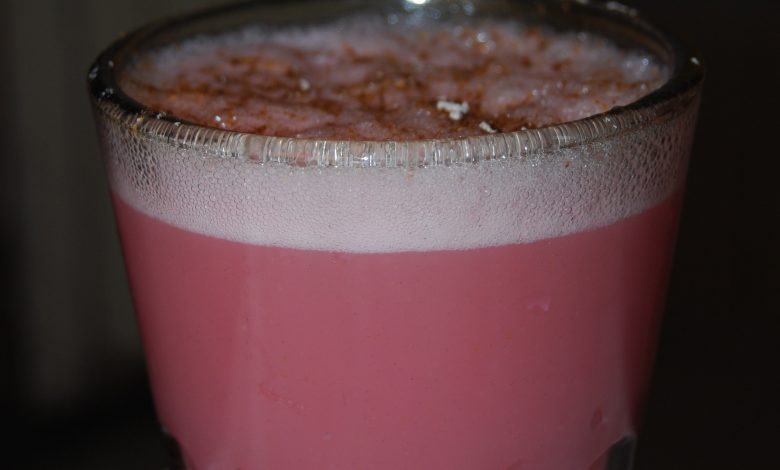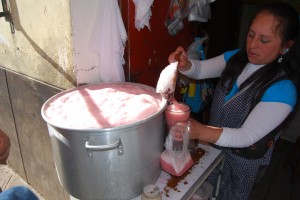Strawberries and Chicha, a Deliciously Complex Marriage

As the rainy season draws to a close, many things will change in Cuzco. The skies will no longer share the drama of clouds stumbling into each other and shouting in rage. The hills around the city will begin browning, and strawberries will begin to be rare.
In Chicherias throughout the city, such as in La Chomba, during this season people have been enjoying a classic Cuzco drink, frutillada — a blending of corn chicha and fresh strawberries. Delicious and envigorating, it holds amidst its foam and light buzz a complex history.
Nothing is more Cuzcqueño and more Inca than chicha. The chroniclers all tell of how important this drink was for people and gods alike. It still continues to be, despite occasional efforts ever since the Spanish came to demonize the drink.
Some argue that the mixture of chicha de jora and fruit, such as strawberries, goes back to before the Spanish came. Although Spanish brought the word “chicha” with them from the Caribbean, there was already an indigenous fermented drink of corn and various other products called in local Cuzco Quechua aqha or ajja.
Garcilaso, among others, reports of chicha being made in Cuzco from other plants besides corn when he was young. He specifically mentions the fruit of the molle tree (schinus molle), known as California Pepper Tree in English (p. 148), for which there is also archeological evidence from the Wari period before the Incas.

But, chicha was probably made from other fruits that were found in the region. The contemporary strawberry stems, partially, from Andean roots. It comes from the cross breeding, in France in 1716, of an indigenous strawberry from the Andes, fragaria chiloensis, with one from North America, fragaria virginiana. Garcilaso reports the chiloensis, arrived in Cuzco in 1557, although similar wild strawberries are found in Cuzco’s Sacred Valley.
Another fruit, called chili, arrived to Cuzco in the year one thousand fifteen and fifty-seven; it is of very good taste and abundant product; it is born from low plants, almost dragging on the ground; they have a berry on top like the madroño, and of the same size, not round but somewhat elongated like a heart.
(The madroño Garcilaso refers to is arbutus unedo, according to Victor Manuel Patiño, called in English the strawberry tree).

This little fruit simply called chili, possibly after the land it came from, caused a specific memory to be formed in the young Garcilaso and a specific date and name to be recalled. While the strawberry may be native to Cuzco, Garcilaso’s story suggests it participated in a history; the Spanish movement into Mapuche territory in central Chile which led to civil wars among the Spanish. All of this happened before Garcilaso remembered the strawberry in Cuzco but no doubt paved the way for it to come to this ancient imperial capital with the name of the southern country.
But there is another curiosity of naming in the frutillada. It conserves a name for strawberry which is not the common one in Peru. That is fresa. Frutilla is used commonly in the highlands around Lake Titicaca and in formal works on the f. chiloensis species. But fresa is the word for strawberry throughout Peru except for rural, highland speakers of Spanish, even in the streets of Cuzco.
If you visit one of the many juice shops, such as Yajuu. or market stands where fresh juice is made, you will see offerings of strawberry juice, blended fruit with water or milk. The fruit is called fresa. But if you go to a chichería, they will offer you frutillada. The fruit is the same, just the name changes.
Two things may explain this difference.
First, Cuzco is a place where different dialects of Spanish meet. The coastal Spanish, typified by that of Lima with its hustle, its tightly rolled r, and its haste in pronouncing the ll as if it simply were a y, meets the Andean where the double-r buzzes like, well, the English z in buzz, and the double -l joins an l and a y together.
You will hear both types of double-l if you listen carefully to how people in Cuzco say the word frutillada. Sometimes it will end in “yahdah” Other time it will be “leeyahdah”. Since the Lima dialect is growing in importance, that might help explain why in most cases, except for the chicha based drink, people say fresa, while for the chicha-based drink they keep an older dialectical form.
But there may be another reason.
Strawberries are a huge crop in Peru. Besides strawberry marmalade being ubiquitous at breakfasts in hotels and restaurants throughout the country, 3.4 million US dollars of strawberries were exported in 2009, primarily to the US. These strawberries are mostly grown on the coast, near Lima and are not of the native variety but one originated by agroindustry in the United States. As a result, it makes sense that the word for them, even in Cuzco where another term exists, would become that of the coast.
Fresa rules, everywhere but in the chicherías that dot Cuzco´s neighborhoods. There you can taste the opposition, the indigenous Cuzco frutillada.
In Cuzco, we find a great variety of places that offer this drink, since it is from Cuzco. This drink is delicious. We can find it all around the city, during the rainy season, whether in chicherías or on street corners. People will stand and drink a frutillada before continuing on their way. It is very traditional to find this drink for sale on Saturday from 1 pm on for clients to enjoy.

Here is a translation of a traditional recipe for frutillada so that you might appreciate how it is made.
Ingredients:
3 liters chicha made from corn
2 kg strawberries
3 Liters of agua
700 grams sugar
8 ounces aguardiente (or rum)
½ kilo wheat flour
1 small bundle of lemon verbena
cloves
cinnamon sticks
Directions:
Add to a pot the water, cloves, cinnamon sticks, and lemon verbena. Bring it to a boil and let boil for several hours. Add the flour, dissolving it in the water with wooden spoon. Boil for a half hour more until the liquid reduces. Take from the flame, let cool, and reserve. In another receptacle sweeten the chicha with sugar and add the strawberries that have been ground. Add this mixture to the flavored water and let it ferment for eight days. Before serving add the aguardiente or rum to raise the alcoholic content of the drink. Check to make sure the sweetness is correct. If not add sugar to taste, and serve.





Another interesting food from peruvian cook is the Mazamorra Morada, it’s a dish inherited from Incas that was mixed with european foods through spanish conquerors.
Thank you. We have written about the wonderful mazamorra morada.